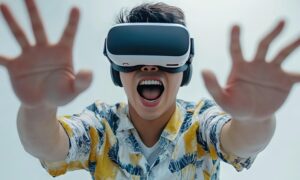Welcome to the future, where technology seamlessly becomes a part of our bodies, empowering us with endless possibilities and revolutionizing the way we approach health and fitness. From wristbands that track our steps to smart clothing that monitors our heart rate, wearable tech innovations have become more than just gadgets – they are capable companions on our journey towards a healthier and fitter lifestyle.
Introduction to Wearable Technology
Wearable technology is an emerging trend in the tech industry, gaining widespread popularity among consumers. It refers to any electronic device or technology that can be worn on the body, either as an accessory or as part of clothing. These devices are equipped with advanced sensors and computing capabilities, enabling them to collect and process data in real-time.
These days, wearable technology is not limited to just fitness trackers or smartwatches. It has expanded into various industries such as healthcare, fashion, entertainment, sports, and even gaming. The potential applications of wearable tech are endless and constantly evolving.
Evolution of Wearable Technology:
The concept of wearable technology dates back to the 13th century when eyeglasses were invented by Salvino D’Armate in Italy. However, it wasn’t until the late 20th century that we saw significant advancements in this field.
At first, wearables were primarily used for medical purposes such as hearing aids and pacemakers. In 1984, Steve Mann created the first-ever wearables computer called “EyeTap” that could capture images and display information in front of the user’s eye.
With the advancements in microelectronics and wireless communication technologies in the early 2000s came new possibilities for wearable technology. In 2009, Fitbit introduced the first fitness tracker that could track users’ physical activity and sleep patterns. The launch of Google Glass in 2012 marked a significant milestone in wearable tech history as it was the first smart glass to hit the market.
Currently, we are seeing an explosion of wearable devices on the market, ranging from smartwatches, fitness trackers, and smart clothing to augmented reality headsets and even implantable devices.
Features and Capabilities of Wearable Technology
1. Sensors: Wearable tech devices are equipped with various types of sensors such as accelerometers, gyroscopes, heart rate monitors, GPS, and thermometers. These sensors enable the device to collect data about the user’s movements, biometric data, location, and environment.
2. Connectivity: Wearables have advanced connectivity capabilities such as Bluetooth, Wi-Fi, cellular connectivity that allows them to exchange data with other devices or connect to the internet.
3. Computing Power: Despite their small size, wearables have powerful processors that can process data in real-time and perform complex tasks.
4. Battery Life: Since wearables are designed to be worn for extended periods, they come with long-lasting batteries that can power the device for several days or even weeks.
Definition and Evolution of Wearable Tech
Wearable technology, also known as wearables, has become a buzzword in recent years. It refers to devices and gadgets that can be worn on the body, either as an accessory or as an item of clothing. These devices are equipped with advanced electronic technologies and sensors that enable them to collect, process, and transmit data.
The concept of wearable technology is not new. The history of wearable tech dates back to the 17th century when the first wearable watch was invented by Peter Henlein in 1600s Germany. However, it was not until the turn of the 21st century that we witnessed a rapid evolution in this field due to advancements in electronic components and miniaturization techniques.
In its early stages, wearables primarily consisted of simple wristwatches with basic features such as timekeeping and alarm functions. But with time, as technology progressed, so did wearables. Today’s wearables are sophisticated pieces of equipment with capabilities beyond what many could have imagined just a decade ago.
One significant milestone in the evolution of wearables was the introduction of fitness trackers in the early 2000s. These small devices were designed to monitor physical activity levels and provide accurate data on steps taken, distance covered, heart rate monitoring, and more. The success and popularity of fitness trackers sparked further developments in this area leading to a range of smartwatches that incorporate additional features such as GPS tracking for outdoor activities like running or cycling.
7 Fascinating Examples of Wearable Tech:
Wearable technology, also known as wearables, has been gaining popularity in recent years. It refers to any electronic device that can be worn on the body and connects to other devices or the internet. These devices are designed to enhance daily activities such as fitness, communication, and productivity. The range of wearable tech is constantly evolving and expanding, with new and exciting developments being made every day.
Let’s take a closer look at some of the most fascinating examples of wearable tech that are changing the way we live our lives:
1. Smartwatches: Smartwatches have become increasingly popular in recent years due to their ability to track fitness activities, receive notifications from your phone, make calls and even pay for purchases. With features like heart rate monitoring and sleep tracking, smartwatches have become essential for many individuals looking to stay connected while maintaining an active lifestyle.
2. Fitness Trackers: Another popular type of wearable tech is fitness trackers. These small devices are designed specifically for measuring physical activity such as steps taken, calories burned, and distance traveled throughout the day. They often come with accompanying apps that allow users to set goals, monitor progress and connect with friends for friendly competitions.
3. Virtual Reality Headsets: Virtual reality (VR) headsets have revolutionized gaming by providing an immersive experience where players feel like they are inside the game itself. But VR technology goes beyond just gaming; it has been used in various fields such as therapy sessions for patients with anxiety disorders or phobias, in military training, and even in real estate to give potential buyers a virtual tour of properties.
4. Smart Clothing: Wearable technology is not limited to devices that are worn on the wrist or head. There has been a rise in smart clothing designed with embedded sensors and conductive fibers that can track biometric data, monitor posture, and even charge electronic devices.
5. Gesture Control Devices: These wearable tech devices allow users to control their electronics using simple hand gestures. For example, the Myo armband uses electromyography (EMG) sensors to read electrical activity from muscles and translate them into commands for various devices such as computers, music players, and video games.
6. Smart Rings: Smart rings are small devices worn on your finger that can perform various functions such as tracking fitness activities, making payments, or monitoring sleep patterns. They usually connect to your phone through Bluetooth and have similar capabilities as a smartwatch in a more compact form.
7. Smart Glasses: Smart glasses are equipped with functionality like Wi-Fi connectivity, touchpad controls, and GPS navigation features. They also have built-in cameras that offer augmented reality experiences by superimposing digital content onto the real world.
Advantages and Disadvantages of Wearable Tech
1. Advantages of Wearable Tech
a. Convenience and Portability – One of the biggest advantages of wearable tech is its convenience and portability. These devices can be worn on the body, freeing up our hands and allowing us to move around without being weighed down by bulky gadgets.
b. Real-time Access to Information – Wearable tech has made it easier than ever to access information in real-time. With smartwatches, fitness trackers, and other wearable devices, we can receive notifications, updates, and alerts directly on our wrists or heads without having to constantly check our phones.
c. Improved Health and Fitness Tracking – From counting steps to monitoring heart rate, wearable tech has revolutionized the way we track our health and fitness goals. These devices provide accurate data that can help us make more informed decisions about our physical well-being.
d. Enhanced Productivity – Another advantage of wearable tech is its ability to enhance productivity by keeping us connected no matter where we are or what we’re doing. With features like voice commands and text-to-speech capabilities, we can stay productive while on-the-go.
e. Personalization – Many wearable tech devices allow for personalization based on individual preferences and needs. This means that each person can customize their device settings according to their specific requirements, making it a truly personalized experience.
2. Disadvantages of Wearable Tech
a. Cost- Like most cutting-edge technology, wearable devices often come at a high price point which may not be affordable for everyone. This could limit access to these devices and their benefits for some individuals.
b. Dependence on Technology – As wearable tech becomes more advanced, there is a risk of becoming overly dependent on these devices and losing basic skills and abilities, such as navigation or memory.
c. Privacy Concerns – With the amount of personal data collected by wearable tech, there are legitimate privacy concerns. This information could potentially be accessed by third parties without the user’s permission, raising questions about who has control over our personal data.
d. Health Risks – The long-term health risks associated with prolonged use of wearable tech, particularly those that emit radiation like smartwatches and VR headsets, are still unknown. This raises concerns about potential negative effects on our health.
e. Limited Battery Life – Many wearable devices have limited battery life, which means that they need to be charged frequently. This can be inconvenient for users who need to constantly monitor their device usage and may not always have access to a power source.
Impact on Daily
Wearable technology has undoubtedly transformed our daily lives in a multitude of ways. From tracking our steps and heart rate to streaming music and receiving notifications, these innovative gadgets have become an integral part of our daily routine. In this section, we will delve into the various areas where wearable tech has made a significant impact on our day-to-day activities.
1. Fitness and Health
One of the most popular uses of wearable tech is in the realm of fitness and health. Wearable devices, such as fitness trackers and smartwatches, have revolutionized how we monitor our physical activity levels and overall wellbeing.
The advancements in sensors and biometric technology have allowed these devices to accurately track metrics such as steps taken, distance covered, calories burned, heart rate, sleep patterns and more. This data can then be synced with smartphone apps or other devices to provide users with detailed insights into their health and fitness journey.
Moreover, many fitness wearables now come equipped with features like GPS tracking, workout guidance personalized coaching programs, making it easier for individuals to stay motivated towards achieving their goals.
2. Communication
Another significant impact that wearables have had on our daily lives is in terms of communication. With the rise of smartwatches, people no longer need to constantly take out their phones to check messages or emails. Instead, they can simply glance at their wrist for important updates without disrupting their flow or activities.
Conclusion
Wearable technology has come a long way from simple wristwatches to advanced headsets, and its potential for the future is endless. It has not only made our lives more convenient through its various functions but also opened up new possibilities in healthcare, fitness, and even fashion. As we continue to push the boundaries of innovation, who knows what exciting advancements may be in store for us? The future of wearable tech is definitely something to keep an eye on!



































